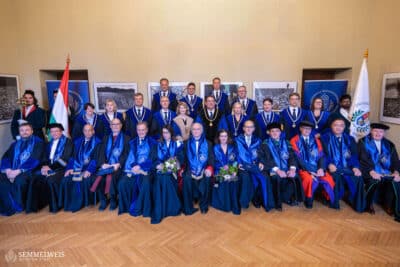Ten young researchers were awarded with the Junior Prima Award in the category of “Hungarian Science”, among them Dr. András Attila Horváth, assistant professor of the Department of Anatomy, Hystology and Embryology at Semmelweis University, as well as Dr. Márton Kolossváry, Dr. Csaba Mátyás and Dr. Zsófia László, who all acquired their PhD degree at the university.
Among the ten young Hungarian researchers, who were awarded with the Junior Prima Award in the category of “Hungarian Science”, there are three former students, as well as an assistant professor of Semmelweis University. The recognition was awarded to its recipients for the 14th time this year; the professional group of judges decided about the awardees on the basis of the nominations provided by research institutes, recognized scientists and professors by taking the nominees’ national and international achievements, publications as well as the novelty of their research work into consideration. The Junior Prima Award can be received by those young researchers and scientists under the age of 33, whose scientific merits are remarkable and exemplary for their peers.
 Dr. András Attila Horváth graduated at the Faculty of Medicine at Semmelweis University in 2014, and he finished his PhD studies at the Doctoral School of Neurosciences (“János Szentágothai”) in 2018. He has been assistant professor at the Department of Anatomy, Hystology and Embryology at Semmelweis University as well as chief research scientist at the National Institute of Clinical Neurosciences since 2018. In the past years, he was doing research focusing on Alzheimer’s disease and epilepsy, but he is also interested in the early diagnostics of neurofibromatosis; multichannel EEG examinations in psychiatric diseases; the neurophysiological examinations in neurodegenerative diseases; polisomnography in epilepsy and in psychiatric disorders; as well as the relationship between neurocognitive diseases and epilepsy. The most outstanding effect of his scientific achievements is the change in perceptive, according to which the electrophysiological symptoms appearing in diseases of cognitive disorders (which were considered to be benign earlier) can be interpreted as the sign of the neural over-activation of the cortex, and these may stand for a common pharmaceutical ambush point. This may provide several new therapeutic opportunities in the treatment of neurodegenerative diseases, in autism or childhood ADHD. Dr. Attila András Horváth received the János Bolyai Research Scholarship, the Bolyai+ Research Award and the Albert Szent-Györgyi Young Researchers Award in recognition of his great scientific achievements in 2020.
Dr. András Attila Horváth graduated at the Faculty of Medicine at Semmelweis University in 2014, and he finished his PhD studies at the Doctoral School of Neurosciences (“János Szentágothai”) in 2018. He has been assistant professor at the Department of Anatomy, Hystology and Embryology at Semmelweis University as well as chief research scientist at the National Institute of Clinical Neurosciences since 2018. In the past years, he was doing research focusing on Alzheimer’s disease and epilepsy, but he is also interested in the early diagnostics of neurofibromatosis; multichannel EEG examinations in psychiatric diseases; the neurophysiological examinations in neurodegenerative diseases; polisomnography in epilepsy and in psychiatric disorders; as well as the relationship between neurocognitive diseases and epilepsy. The most outstanding effect of his scientific achievements is the change in perceptive, according to which the electrophysiological symptoms appearing in diseases of cognitive disorders (which were considered to be benign earlier) can be interpreted as the sign of the neural over-activation of the cortex, and these may stand for a common pharmaceutical ambush point. This may provide several new therapeutic opportunities in the treatment of neurodegenerative diseases, in autism or childhood ADHD. Dr. Attila András Horváth received the János Bolyai Research Scholarship, the Bolyai+ Research Award and the Albert Szent-Györgyi Young Researchers Award in recognition of his great scientific achievements in 2020.
 Dr. Márton Kolossváry graduated at the Faculty of Medicine of Semmelweis University in 2016, and he defended his PhD thesis in 2019. He has been a member of the Hungarian Academy of Sciences – Semmelweis University Cardiovascular Imaging Research Group since 2011, this area of research is his main scientific interest as well. He was the first to apply the radiomedical image diagnostic method in the area of cardiovascular imaging on an international level. For this, he invented an open source software (RIA: Radiomics Image Analysis), which has been already downloaded by more than 100 thousand people. With the help of radiomedical analyses, he managed to prove that there are much more information available on the CT scans prepared about the coronary system as opposed to what we are capable of identifying with the naked eye. Currently he is the scientific director of Neumann Medical Ltd. and postdoctoral researcher of Harvard Medical School MGH.
Dr. Márton Kolossváry graduated at the Faculty of Medicine of Semmelweis University in 2016, and he defended his PhD thesis in 2019. He has been a member of the Hungarian Academy of Sciences – Semmelweis University Cardiovascular Imaging Research Group since 2011, this area of research is his main scientific interest as well. He was the first to apply the radiomedical image diagnostic method in the area of cardiovascular imaging on an international level. For this, he invented an open source software (RIA: Radiomics Image Analysis), which has been already downloaded by more than 100 thousand people. With the help of radiomedical analyses, he managed to prove that there are much more information available on the CT scans prepared about the coronary system as opposed to what we are capable of identifying with the naked eye. Currently he is the scientific director of Neumann Medical Ltd. and postdoctoral researcher of Harvard Medical School MGH.
 Dr. Csaba Mátyás graduated at Semmelweis University as a medical doctor in 2012. He acquired a dual PhD degree in 2017 as the medical student of both Semmelweis University and the program of the National Institutes of Health Graduate Partnership. His most significant professional achievements are related to the description of the functional and molecular mechanism of heart failure connected to diabetes as well as the pathophysiological description of myocardiac damage connected to chronic hepatic insufficiencies. Besides these, the following areas are also among his professional interests: cardiovascular pathology and pathophysiology; oxidative stress; echocardiogram; invasive haemodynamics and vascular intervention. Currently he is postdoctoral researcher of the National Institute on Alcohol Abuse and Alcoholism/ National Institutes of Health in the United States.
Dr. Csaba Mátyás graduated at Semmelweis University as a medical doctor in 2012. He acquired a dual PhD degree in 2017 as the medical student of both Semmelweis University and the program of the National Institutes of Health Graduate Partnership. His most significant professional achievements are related to the description of the functional and molecular mechanism of heart failure connected to diabetes as well as the pathophysiological description of myocardiac damage connected to chronic hepatic insufficiencies. Besides these, the following areas are also among his professional interests: cardiovascular pathology and pathophysiology; oxidative stress; echocardiogram; invasive haemodynamics and vascular intervention. Currently he is postdoctoral researcher of the National Institute on Alcohol Abuse and Alcoholism/ National Institutes of Health in the United States.
 Dr. Zsófia László graduated at Loránd Eötvös University in 2013 as a biologist, and she acquired her summa cum laude PhD degree at the Doctoral School of Neurosciences (“János Szentágothai”) at Semmelweis University in 2020. Her most significant scientific achievement is the discovery of the phenomenon called “developmental anoikis” (in other words “developmental homelessness”), which was published in the prestigious Nature Communications journal on 31 August, 2020. In her study, Dr. Zsófia László revealed the inevitable role of ABHD4 enzyme in this phenomenon, with which she was the first to present the physiological role of a protein with a so far unknown function. Currently she is assistant research fellow at the Institute of Experimental Medicine.
Dr. Zsófia László graduated at Loránd Eötvös University in 2013 as a biologist, and she acquired her summa cum laude PhD degree at the Doctoral School of Neurosciences (“János Szentágothai”) at Semmelweis University in 2020. Her most significant scientific achievement is the discovery of the phenomenon called “developmental anoikis” (in other words “developmental homelessness”), which was published in the prestigious Nature Communications journal on 31 August, 2020. In her study, Dr. Zsófia László revealed the inevitable role of ABHD4 enzyme in this phenomenon, with which she was the first to present the physiological role of a protein with a so far unknown function. Currently she is assistant research fellow at the Institute of Experimental Medicine.
This year, the official awards ceremony cannot be held at the Hungarian Academy of Sciences due to the current epidemiological situation.
Ádám Szabó
Source of photo and laudations: Hungarian Development Bank – Prima Junior 2020 Publication
Translation: Katalin Illés-Romhányi


